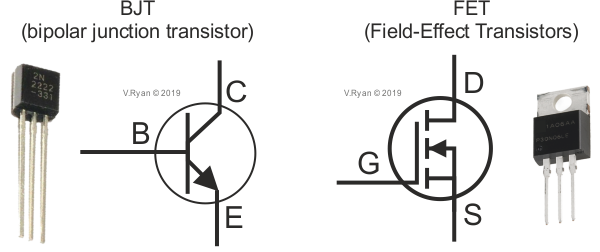How does a transistor work?
A transistor is a fundamental semiconductor device that plays a pivotal role in modern electronics by acting as an amplifier and a switch. It operates based on the principles of semiconductor behavior and is typically composed of three layers: the emitter, base, and collector.
In a common type of transistor, the bipolar junction transistor (BJT), there are two types: NPN and PNP. When a small current flows from the base to the emitter in an NPN transistor (or from emitter to base in a PNP), it creates a larger current flow from the collector to the emitter (or emitter to collector) due to the configuration of the layers and their doping.
This small base current controls the much larger collector-emitter current, effectively amplifying the input signal. The transistor acts as an on-off switch when it’s operated in either its “cut-off” (no collector current) or “saturation” (full collector current) states.
The field-effect transistor (FET) is another major type, operating on the principle of electric fields. It has three terminals: source, gate, and drain. By applying a voltage to the gate, the electric field controls the flow of current between the source and the drain, making FETs efficient in high-frequency and low-power applications.
Transistors have revolutionized electronics, enabling compact and efficient circuit design, and serving as building blocks for various devices such as computers, amplifiers, and communication systems. Their ability to amplify and switch signals with great precision has driven the advancement of modern technology.

A transistor is a fundamental electronic device that is used to control the flow of electrical current. It is a three-terminal device consisting of a semiconductor material, typically silicon or germanium. The basic operation of a transistor relies on the interaction between two types of semiconductor material: N-type (negative-type) and P-type (positive-type).
There are two common types of transistors: the bipolar junction transistor (BJT) and the field-effect transistor (FET). I’ll provide a brief overview of both types:
- Bipolar Junction Transistor (BJT):
– The BJT has three layers of semiconductor material: the emitter (N-type), the base (P-type), and the collector (N-type). It can be either an NPN or a PNP transistor.
– When a voltage is applied to the base-emitter junction (for an NPN transistor) or reversed for a PNP transistor, it affects the flow of majority charge carriers (electrons or holes) in the base region.
– In an NPN transistor, when a small current flows from the base to the emitter, it allows a much larger current to flow from the collector to the emitter.
– The flow of current from the collector to the emitter can be controlled by the small current at the base, allowing the transistor to amplify and switch electrical signals. - Field-Effect Transistor (FET):
– The FET has three terminals: the source, the drain, and the gate. The semiconductor material has either an N-type or P-type channel.
– The key component in an FET is the gate, which is separated from the channel by an insulating layer (usually made of silicon dioxide).
– By applying a voltage to the gate, an electric field is created that controls the flow of charge carriers in the channel.
– In a metal-oxide-semiconductor FET (MOSFET), the gate voltage controls the conductivity of the channel, allowing the transistor to act as an amplifier or a switch.
In summary, both BJT and FET transistors operate based on the control of current or charge carriers in a semiconductor material. They can amplify weak signals, switch electrical currents on and off, and form the building blocks of modern electronic devices, such as computers, smartphones, and amplifiers.

